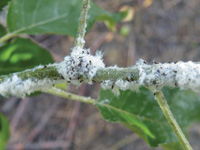 Woolly apple aphid (Eriosoma lanigerum) is usually considered a ‘secondary’ pest of apple trees, but it appears to be increasing across Australia.
Woolly apple aphid (Eriosoma lanigerum) is usually considered a ‘secondary’ pest of apple trees, but it appears to be increasing across Australia.
Changes in orchard rootstocks (M9 and M26) and microclimate (protective canopies) have resulted in more favourable conditions for woolly aphid to prosper.
Extreme heat during the season and/or toxic broad-spectrum insecticides (e.g. Lorsban) can also upset biological predators such as Aphelinus mali, and earwigs.
The three main problems associated with woolly aphid infestations are:
- Secretion of honeydew which falls onto fruit—sooty mould can develop on the honeydew reducing the marketability of fruit
- Orchard workers can complain about the effects of the aphid
- Severe aphid infestations can kill shoots and reduce the viability of buds for following seasons.
Life Cycle
Woolly aphid can have 10 to 20 generations a season and females can give birth to 100 crawlers depending on environmental conditions.
Woolly aphid can overwinter on tree roots or in injured parts of the tree such as pruning wounds. In the spring, crawlers emerge from the soil and colonise the tree.
Woolly aphid can spread through the orchard in the wind.
The pest can be introduced into an orchard on the roots of new trees from the nursery so it is a good idea to treat nursery trees prior to planting.
For more information, see the November 2011 issue of Tree Fruit



















